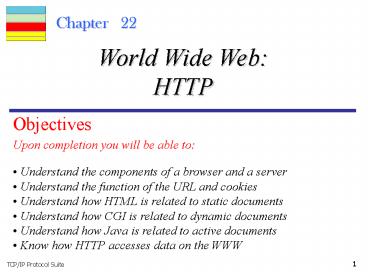Upon completion you will be able to: - PowerPoint PPT Presentation
1 / 36
Title:
Upon completion you will be able to:
Description:
The request line shows the method (GET), the URL, and the ... The header has two lines that show that the client can accept images in the GIF or JPEG format. ... – PowerPoint PPT presentation
Number of Views:50
Avg rating:3.0/5.0
Title: Upon completion you will be able to:
1
Chapter 22
World Wide WebHTTP
Objectives
Upon completion you will be able to
- Understand the components of a browser and a
server - Understand the function of the URL and cookies
- Understand how HTML is related to static
documents - Understand how CGI is related to dynamic
documents - Understand how Java is related to active
documents - Know how HTTP accesses data on the WWW
2
22.1 ARCHITECTURE
The WWW is a distributed client-server service,
in which a client using a browser can access a
service using a server. The service provided is
distributed over many locations called sites.
The topics discussed in this section include
Client (Browser) Server Uniform Resource
Locator (URL) Cookies
3
Figure 22.1 Architecture of WWW
4
Figure 22.2 Browser
5
Figure 22.3 URL
6
22.2 WEB DOCUMENTS
The documents in the WWW can be grouped into
three broad categories static, dynamic, and
active. The category is based on the time the
contents of the document are determined.
The topics discussed in this section include
Static Documents Dynamic Documents Active
Documents
7
Figure 22.4 Static document
8
Figure 22.5 Boldface tags
9
Figure 22.6 Effect of boldface tags
10
Figure 22.7 Beginning and ending tags
11
Figure 22.8 Dynamic document using CGI
12
Figure 22.9 Dynamic document using server-site
script
13
Note
Dynamic documents are sometimes referred to as
server-site dynamic documents.
14
Figure 22.10 Active document using Java applet
15
Figure 22.11 Active document using client-site
script
16
Note
Active documents are sometimes referred to as
client-site dynamic documents.
17
22.3 HTTP
The Hypertext Transfer Protocol (HTTP) is a
protocol used mainly to access data on the World
Wide Web. HTTP functions like a combination of
FTP and SMTP.
The topics discussed in this section include
HTTP Transaction Persistent versus Nonpersistent
Connection Proxy Server
18
Note
HTTP uses the services of TCP on well-known port
80.
19
Figure 22.12 HTTP transaction
20
Figure 22.13 Request and response messages
21
Figure 22.14 Request and status lines
22
Table 22.1 Methods
23
Table 22.2 Status codes
24
Table 22.2 Status codes (continued)
25
Figure 22.15 Header format
26
Table 22.3 General headers
27
Table 22.4 Request headers
28
Table 22.5 Response headers
29
Table 22.6 Entity headers
30
Example 1
This example retrieves a document. We use the GET
method to retrieve an image with the path
/usr/bin/image1. The request line shows the
method (GET), the URL, and the HTTP version
(1.1). The header has two lines that show that
the client can accept images in the GIF or JPEG
format. The request does not have a body. The
response message contains the status lineand
four lines of header. The header lines define the
date, server, MIME version, and length of the
document. The body of the document follows the
header (see Figure 22.16).
See Next Slide
31
Figure 22.16 Example 1
32
Example 2
In this example, the client wants to send data to
the server. We use the POST method. The request
line shows the method (POST), URL, and HTTP
version (1.1). There are four lines of headers.
The request body contains the input information.
The response message contains the status line and
four lines of headers. The created document,
which is a CGI document, is included as the body
(see Figure 22.17).
See Next Slide
33
Figure 22.17 Example 2
34
Example 3
HTTP uses ASCII characters. A client can directly
connect to a server using TELNET, which logs into
port 80. The next three lines shows that the
connection is successful. We then type three
lines. The first shows the request line (GET
method), the second is the header (defining the
host), the third is a blank terminating the
request. The server response is seven lines
starting with the status line. The blank line at
the end terminates the server response. The file
of 14230 lines is received after the blank line
(not shown here). The last line is the output by
the client.
See Next Slide
35
Example 3
telnet www.mhhe.com 80Trying
198.45.24.104...Connected to www.mhhe.com
(198.45.24.104).Escape character is ''.GET
/engcs/compsci/forouzan HTTP/1.1From
forouzanbehrouz_at_fhda.edu HTTP/1.1 200 OKDate
Thu, 28 Oct 2004 162746 GMTServer
Apache/1.3.9 (Unix) ApacheJServ/1.1.2 PHP/4.1.2
PHP/3.0.18MIME-version1.0Content-Type
text/htmlLast-modified Friday, 15-Oct-04
021131 GMTContent-length 14230 Connection
closed by foreign host.
36
Note
HTTP version 1.1 specifies a persistent
connection by default.












![Download [PDF] Once Upon A Claim: Fairy Tales to Protect Your Ass(ets) Hardcover – PowerPoint PPT Presentation](https://s3.amazonaws.com/images.powershow.com/10086602.th0.jpg?_=20240726087)


















